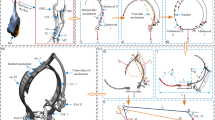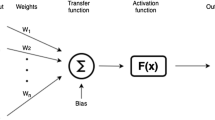Abstract
In recent years, uninhabited aerial vehicles (UAV) have been used for oilfield inspections in many enterprises which can realize oilfield inspections by fewer workers. Path planning is one indispensable element in oilfield inspections through UAVs and it is also a complicated optimal problem. Now, although many researches have been focused on it, they are mainly discussed based on two-dimension planes. In practices, oilfields are complex three-dimensional spaces with many targeted points and moving obstacles between the starting and the ending point, which bring current methods some difficulties. In order to solve this problem, a three-dimensional environment model for oilfields is established for the first time, which includes: a static oil-well equipment, moving obstacles, and so on. Then, a cost function is defined to evaluate the best path, which includes: total length, average height, total time, and total electricity consumption. Finally, an improved pigeon-inspired optimization algorithm is proposed to solve problems about path planning in a three-dimensional dynamic environment of oilfields, which is named PIOFOA. In the PIOFOA, a pigeon-inspired optimization (PIO) algorithm is used to optimize the initial path and a fruit fly optimization algorithm (FOA) is used to continue local optimizations, so as to search the best path after movements of obstacles. Compared with some other methods, simulation results show that the proposed PIOFOA method is more effective.

















Similar content being viewed by others
References
Shukla A, Xiaoqian H, Karki H (2016) Autonomous tracking of oil and gas pipelines by an unmanned aerial vehicle, IEEE
Cho J, Lim G, Biobaku T, Kim S, Parsaei H (2015) Safety and security management with unmanned aerial vehicle (UAV) in oil and gas industry. Procedia Manuf 3:1343–1349
Gomez C, Green DR (2017) Small unmanned airborne systems to support oil and gas pipeline monitoring and mapping. Arab J Geosci 10(9):202–219
Montiel O, Orozco-Rosas U, Seplveda R (2015) Path planning for mobile robots using bacterial potential field for avoiding static and dynamic obstacles. Expert Syst Appl 42(12):5177–5191
Zhang S, Zhou Y, Li Z, Pan W (2016) Grey wolf optimizer for unmanned combat aerial vehicle path planning. Adv Eng Softw 99(C):121–136
Shorakaei H, Vahdani M, Imani B, Gholami A (2016) Optimal cooperative path planning of unmanned aerial vehicles by a parallel genetic algorithm. Robotica 34(4):823–836
Zhang B, Liu W, Mao Z, Liu J, Shen L (2014) Cooperative and geometric learning algorithm (CGLA) for path planning of uavs with limited information. Automatica 50(3):809–820
Morales N, Toledo J, Acosta L (2016) Path planning using a multiclass support vector machine. Appl Soft Comput 43:498–509
Yang P (2015) Path planning for single unmanned aerial vehicle by separately evolving waypoints. IEEE Trans Robot 31(5):1130–1146
Liu W, Zheng Z, Cai KY (2013) Bi-level programming based real-time path planning for unmanned aerial vehicles. Knowl-Based Syst 44(44):34–47
Fu Y, Ding M, Zhou C, Hu H (2013) Route planning for unmanned aerial vehicle (UAV) on the sea using hybrid differential evolution and quantum-behaved particle swarm optimization. IEEE Trans Syst Man Cybern Syst 43(6):1451– 1465
Yan Y, Liang Y, Zhang H, Zhang W, Feng H, Wang B, Liao Q (2019) A two-stage optimization method for unmanned aerial vehicle inspection of an oil and gas pipeline network. Pet Sci 16(5):458–468
Sun X, Yao W, Liu Y, Qi N (2015) Triple-stage path prediction algorithm for real-time mission planning of multi-UAV. Electron Lett 51(19):1490–1492
Csiszar A, Drust M, Dietz T, Verl A, Brisan C (2012) Dynamic and interactive path planning and collision avoidance for an industrial robot using artificial potential field based method. Mechatronics, 413–421
Wang H, Wentao L, Peng Y, Xiao L, Chang L (2015) Three-dimensional path planning for unmanned aerial vehicle based on interfered fluid dynamical system. Chin J Aeronaut 28(1):229–239
Zhang Z. Ding, S (2019) A hybrid optimization algorithm based on cuckoo search and differential evolution for solving constrained engineering problems. Eng Appl Artif Intel 85:254–268
Zhang X, Duan H (2015) An improved constrained differential evolution algorithm for unmanned aerial vehicle global route planning. Appl Soft Comput 26:270–284
YongBo C, YueSong M, JianQiao Y, XiaoLong S, Nuo X (2017) Three-dimensional unmanned aerial vehicle path planning using modified wolf pack search algorithm. Neurocomputing 266:445–457
Ma Y, Zamirian M, Yang Y, Xu Y, Zhang J (2013) Path planning for mobile objects in four-dimension based on particle swarm optimization method with penalty function. Math Probl Eng 2013:1–9
Das PK, Behera HS, Panigrahi BK (2016) A hybridization of an improved particle swarm optimization and gravitational search algorithm for multi-robot path planning. Swarm Evol Comput 28:14–28
Duan H, Yu Y, Zhang X, Shan S (2010) Three-dimension path planning for ucav using hybrid meta-heuristic ACO-DE algorithm. Simul Model Pract Theory 18(8):1104–1115
Wang GG, Chu HCE, Mirjalili S (2016) Three-dimensional path planning for ucav using an improved bat algorithm. Aerosp Sci Technol 49:231–238
Phung MD, Cong HQ, Dinh TH, Ha Q (2017) Enhanced discrete particle swarm optimization path planning for UAV vision-based surface inspection. Autom Constr 81:25–33
Dewangan RK, Shukla A, Godfrey WW (2019) Three dimensional path planning using grey wolf optimizer for UAVs. Appl Intell, 2201–2217
Chen Y, Yu J, Mei Y, Wang Y, Su X (2016) Modified central force optimization (MCFO) algorithm for 3D UAV path planning. Neurocomputing 171(C):878–888
Pandey P, Shukla A, Tiwari R (2017) Three-dimensional path planning for unmanned aerial vehicles using glowworm swarm optimization algorithm. Int J Syst Assur Eng Manag 9(10):1–17
Duan H, Qiao P (2014) Pigeon-inspired optimization: a new swarm intelligence optimizer for air robot path planning. Int J Intell Comput Cybern 7(1):24–37
Deng Y, Duan H (2016) Control parameter design for automatic carrier landing system via pigeon-inspired optimization. Nonlin Dyn 85(1):1–10
Zhang B, Duan H (2017) Three-dimensional path planning for uninhabited combat aerial vehicle based on predator-prey pigeon-inspired optimization in dynamic environment. IEEE/ACM Trans Comput Biol Bioinform 14(1):97–107
Zhang S, Duan H (2014) Gaussian pigeon-inspired optimization approach to orbital spacecraft formation reconfiguration. Chin J Aeronaut 28(1):200–205
Zhang T, Duan H (2017) A modified consensus algorithm for multi-UAV formations based on pigeon-inspired optimization with a slow diving strategy. J Intell Syst (in China) 12(4):570–581
Pan WT (2012) A new fruit y optimization algorithm: taking the financial distress model as an example. Knowl-Based Syst 26(2):69–74
Ling W, Zheng XL, Wang SY (2013) A novel binary fruit fly optimization algorithm for solving the multidimensional knapsack problem. Knowl-Based Syst 48(2):17–23
Pan QK, Sang HY, Duan JH, Gao L (2014) An improved fruit fly optimization algorithm for continuous function optimization problems. Knowl-Based Syst 62(5):69–83
Sheng W, Bao Y (2013) Fruit fly optimization algorithm based fractional order fuzzy-PID controller for electronic throttle. Nonlin Dyn 73(1–2):611–619
Ding S, Zhang X, Yu J (2016) Twin support vector machines based on fruit fly optimization algorithm. Int J Mach Learn Cybern 7(2):193–203
Vannoy J, Jing X (2008) Real-time adaptive motion planning (RAMP) of mobile manipulators in dynamic environments with unforeseen changes. IEEE Trans Robot 24(5):1199–1212
Roberge V, Tarbouchi M, Labonte G (2013) Comparison of parallel genetic algorithm and particle swarm optimization for real-time UAV path planning. IEEE Trans Industr Inform 9(1):132–141
Rui D, Duan H (2015) Pigeon inspired optimization approach to model prediction control for unmanned air vehicles. Aircraft Eng Aerosp Technol Int J 88(1):108–116
Whiten A (1972) Operant study of sun altitude and pigeon navigation. Nature 237(5355):405–406
Schiffner I, Wiltschko R (2011) Temporal fluctuations of the geomagnetic field affect pigeons entire homing flight. J Comp Physiol A Neuroethol Sens Neural Behav Physiol 197(7):765–772
Strasser R, Bingman VP, Ioal P, Casini G, Bagnoli P (2015) The homing pigeon hippocampus and the development of landmark navigation. Dev Psychobiol 33(4):305–315
Acknowledgments
This work was supported in part by the National Natural Science Foundation of China (Grant 61403040, 61573088, 61773073, 61873041)
Author information
Authors and Affiliations
Corresponding authors
Additional information
Publisher’s note
Springer Nature remains neutral with regard to jurisdictional claims in published maps and institutional affiliations.
Rights and permissions
About this article
Cite this article
Ge, F., Li, K., Han, Y. et al. Path planning of UAV for oilfield inspections in a three-dimensional dynamic environment with moving obstacles based on an improved pigeon-inspired optimization algorithm. Appl Intell 50, 2800–2817 (2020). https://doi.org/10.1007/s10489-020-01650-2
Published:
Issue Date:
DOI: https://doi.org/10.1007/s10489-020-01650-2




